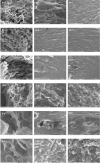Effect of Starch Noodle (Dangmyeon) and Pork Intestines on the Rehydration Stability of Korean Blood Sausage (Sundae)
- PMID: 33506225
- PMCID: PMC7810388
- DOI: 10.5851/kosfa.2020.e87
Effect of Starch Noodle (Dangmyeon) and Pork Intestines on the Rehydration Stability of Korean Blood Sausage (Sundae)
Abstract
This study was conducted to examine the effects of starch noodles (dangmyeon; SNs) with different starch sources and porcine intestines (PIs) with different pH on the rehydration stability of Korean blood sausage (sundae). Mungbean SN3 and PI3 (pH 9.18) showed significantly higher values of 80.69%-91.67% and 79.66%-80.98%, respectively, regardless of the drying methods (hot air, vacuum and freeze drying) (p<0.05). A number of larger pores were observed only in the cross-section of the freeze dried SN and PI through SEM. SN2 (potato starch) and PI3 (pH 9.18) showed lower expansion (*ΔL 6.90 mm) and higher expansion ratio (*ΔL 26.29 mm), respectively, after rehydration of freeze dried sample (p<0.05). From the application of SN2 (potato starch) and PI (0.5%-2.0% Na-pyrophosphate) to freeze dried sundae manufacturing, higher rehydration stability of more than 91.5% was obtained. These results suggested that potato SN and treatment of PI with Na-pyrophosphate is useful for desirable rehydration stability of freeze dried sundae.
Keywords: Korean blood sausage; porcine intestines; rehydration stability; starch noodle; sundae.
© Korean Society for Food Science of Animal Resources.
Conflict of interest statement
The authors declare no potential conflicts of interest.
Figures

References
-
- Baslar M, Kılıçl M, Toker OS, Sağdıç O, Arici M. Ultrasonic vacuum drying technique as a novel process for shortening the drying period for beef and chicken meats. Innov Food Sci Emerg Technol. 2014;26:182–190. doi: 10.1016/j.ifset.2014.06.008. - DOI
-
- Caldironi HA, Ockerman HW. Incorporation of blood proteins into sausage. J Food Sci. 1982;47:405–408. doi: 10.1111/j.1365-2621.1982.tb10091.x. - DOI
-
- Celma AR, Cuadro F, López rodríguezc F. Characterization of industrial tomato by-products from infrared drying process. Food Bioprod Process. 2009;87:282–291. doi: 10.1016/j.fbp.2008.12.003. - DOI
-
- Chen Z. Physicochemical properties of sweet potato starches and their application in noodle products. Wageningen Univ.; Wageningen, Netherlands: 2003. Ph.D. dissertation.
-
- Chen Z, Sagis L, Legger A, Linssen JPH, Schols HA, Voragen AGJ. Evaluation of starch noodles made from three typical Chinese sweet potato starches. J Food Sci. 2002;67:3342–3347. doi: 10.1111/j.1365-2621.2002.tb09589.x. - DOI
Publication types
LinkOut - more resources
Full Text Sources
Other Literature Sources
Research Materials
Miscellaneous

